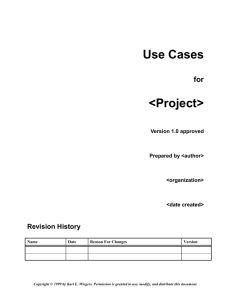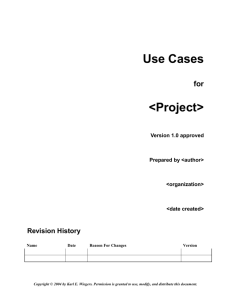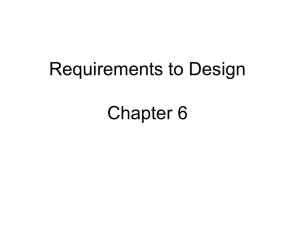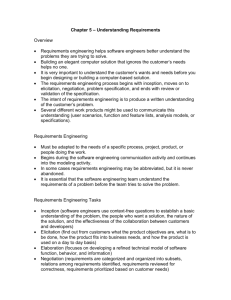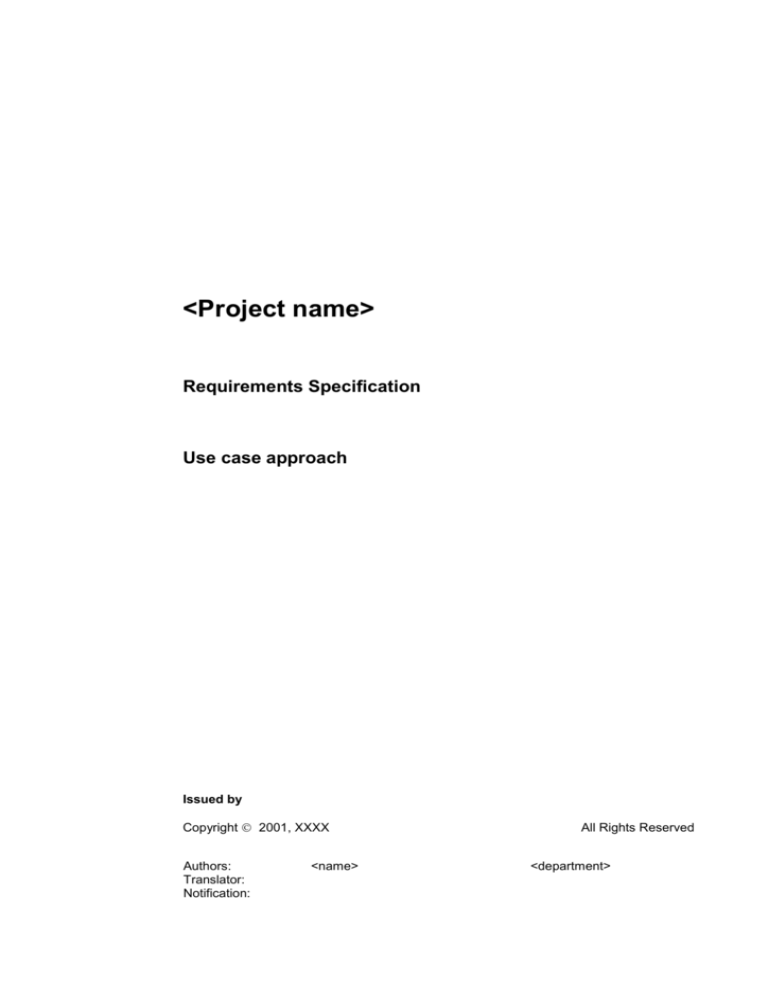
<Project name>
Requirements Specification
Use case approach
Issued by
Copyright 2001, XXXX
Authors:
Translator:
Notification:
<name>
All Rights Reserved
<department>
In addition to the authors named on the cover page the following persons have
collaborated on this document:
<name>
<department>
The document comprises 17 pages, all pages have issue no 01.
This issue was created on 07.03.上午八上午八 08:05.
2
TABLE OF CONTENTS
0
GENERAL INFORMATION
0.1
0.2
0.3
0.4
1
5
Issue Control....................................................................................................... 5
Revision History ................................................................................................. 5
References .......................................................................................................... 5
Glossary and Abbreviations .............................................................................. 5
INTRODUCTION
6
1.1 Scope and purpose ............................................................................................ 6
1.2 Common vocabulary .......................................................................................... 6
1.2.1 Definitions .............................................................................................................................. 6
1.3 Open issues ........................................................................................................ 7
2
SYSTEM OVERVIEW
2.1
2.2
2.3
2.4
3
8
Business Context ............................................................................................... 8
User Characteristics ........................................................................................... 8
Summary of Features ......................................................................................... 8
General Constraints, Assumptions and Dependencies .................................. 9
FUNCTIONAL REQUIREMENTS
10
3.1 Introduction to Use-case concept ................................................................... 10
3.1.1 Use case description contains: .......................................................................................... 11
3.1.2 Relationships between use cases...................................................................................... 11
3.2 User Roles ......................................................................................................... 12
3.2.1 <user role/actor> .................................................................................................................. 12
3.3 Use Cases ......................................................................................................... 13
3.3.1 <Use case package> ............................................................................................................ 13
4
NONFUNCTIONAL REQUIREMENTS
4.1
4.2
4.3
4.4
4.5
4.6
4.7
4.8
4.9
14
External Interface/Interoperability Requirements .......................................... 14
GUI Requirements ............................................................................................ 14
Internal Data Requirements ............................................................................. 14
Design and Implementation Constraints ........................................................ 14
Safety Requirements ........................................................................................ 15
Security and Privacy Requirements ............................................................... 15
HW Requirements ............................................................................................. 15
SW Requirements ............................................................................................. 15
Software Quality Factors ................................................................................. 15
4.9.1 Usability ................................................................................................................................ 15
4.9.2 Reliability .............................................................................................................................. 15
4.9.3 Performance ......................................................................................................................... 15
4.9.4 Supportability ....................................................................................................................... 15
4.9.5 Efficiency Requirements ..................................................................................................... 16
4.9.6 Integrity Requirements ........................................................................................................ 16
4.9.7 Maintainability Requirements ............................................................................................. 16
3
TABLE OF CONTENTS
4.9.8 Testability Requirements .................................................................................................... 16
4.9.9 Flexibility Requirements ..................................................................................................... 16
4.9.10 Portability Requirements ................................................................................................ 16
4.9.11 Reusability Requirements ............................................................................................... 16
5
APPENDICES
17
4
TABLE OF CONTENTS
0
GENERAL INFORMATION
0.1
Issue Control
The document comprises 17 pages, all pages have issue no 01.
This issue was created on 07.03.2016 08:05.
0.2
Issue
Revision History
Date
Reason for Changes
01
Table 1: History
0.3
References
Numbered list of documents, books, links, etc. referenced from within this document.
This section is also known as Bibliography.
0.4
Term
Glossary and Abbreviations
Description
This section describes the abbreviations used within the document.
5
TABLE OF CONTENTS
1
INTRODUCTION
NOTE: a text marked in Italic and blue is an explanation to the respective
section. Please leave it out in your future documents!
1.1
Scope and purpose
Describe the purpose and scope of the application of this document here.
1.2
Common vocabulary
Note: If necessary (mainly for large complex projects), this section could be saved in
a document file called Glossary. In that case leave out the subsequent chapters and
provide a reference.
Present any information the reader might need to this chapter.
This section is used to define terminology specific to the problem domain, explaining
terms, which may be unfamiliar to the reader of the requirements specification or
other project documents.
Often, this section can be used as an informal data dictionary, capturing data
definitions so that use-case descriptions and other project documents can focus on
what the system must do with the information.
1.2.1
Definitions
The terms defined here form the essential substance of this section document. They
can be defined in any order desired, but generally alphabetic order provides the
greatest accessibility.
1.2.1.1
<Name of term 1>
The definition for term 1 is presented here. As much information as the reader needs
to understand the concept should be presented.
1.2.1.2
<Group of terms>
Sometimes it is useful to organize terms into groups to improve readability.
For example, if the problem domain contains terms related to both accounting and
building construction (as would be the case if we were developing a system to
manage construction projects), presenting the terms from the two different subdomains might prove confusing to the reader. To solve this problem, we use
groupings of terms.
In presenting the grouping of terms, provide a short description that helps the reader
understand what this group of terms represents. Terms presented within the group
should be organized alphabetically for easy access.
6
TABLE OF CONTENTS
1.2.1.2.1
<Name of term 1 within group>
The definition for term 1 is presented here. As much information as the reader needs
to understand the concept should be presented.
1.3
Open issues
List here any open issues regarding this document or the topic (requirements
capture) in general.
7
TABLE OF CONTENTS
2
System overview
The purpose of this part is to collect, analyze and define high-level user needs and
features of the product. Focus on capabilities needed by the target users and why
these needs exist.
Details of how the application fulfills these needs are specified in the subsequent
functional and non-functional requirements section, therefore only a brief summary is
provided here.
2.1
Business Context
This subsection should put the system in perspective to other related systems and
the user’s environment. Describe the business context of the system.
Provide a description of this system, where it fits into the Company’s overall
structure, and what functionality is provided by this product. (There might be another
specification, e.g. Project Vision that would cover these items in much more detail
and with far greater depth).
If the system is independent and totally self-contained, state it here. If the system is a
component of a larger system, then this subsection should relate how these systems
interact and should identify the relevant interfaces between the systems. One easy
way to display the major components of the larger system, interconnections and
external interfaces is via a block diagram.
This section shall also provide a high level description of business process to be
supported by IT. You can use a textual description or provide some diagrams.
2.2
User Characteristics
State any User characteristics that may be influential or significant in the structure of
the product.
This section should profile the intended users of the application and the key problems
that limit their productivity. It should not be used to state specific requirements.
Instead, provide the background and justification for why the requirements are
needed.
To effectively provide products and services that meet your customers’ needs, it is
necessary to understand the challenges they confront when performing their jobs.
For example, there could be a Customer (someone who sends a request vie the
system), Administrator (someone who maintains the system), Operator (someone
who handles the customer’s requests via the application), etc.
2.3
Summary of Features
Summarize the major benefits and features the product will provide.
For example, a customer support system may use this part to address problem
documentation, routing and status reporting without mentioning the amount of detail
each of these functions requires.
Organize the functions so the list is understandable to the customer or to anyone
else reading the document for the first time. A simple table listing the key benefits
and their supporting features might suffice.
8
TABLE OF CONTENTS
For example (a customer support system)
System feature
Benefit
Knowledge base assists support personnel in
quickly identifying known fixes and
workarounds
New support staff can quickly get up to speed.
Problems are uniquely itemized, classified and
tracked throughout the resolution process.
Automatic notification occurs for any aging
issues.
Customer satisfaction is improved because
nothing falls through the cracks.
Trend and distribution reports allow high-level
review of problem status.
Management can identify problem areas and
gauge staff workload.
Replication server allows current database
information to be shared across the enterprise
Distributed support teams can work together to
solve problems.
Knowledge base can be made available over
the Internet. Includes hypertext search
capabilities and graphical query engine
Customers can help themselves, lowering
support costs and improving response time.
System feature
Benefit
2.4
General Constraints, Assumptions and Dependencies
Outline here briefly any design constraints, external constraints, or other
dependencies or factors that affect the features stated above.
List assumptions that, if changed, will alter the Vision document. For example, an
assumption may state that a specific operating system will be available for the
hardware designated for the software product. If the operating system is not
available, the Vision document will need to change.
9
TABLE OF CONTENTS
3
Functional requirements
NOTE: Be careful, avoid solution! Do describe customer problem, WHAT he
wants/needs, instead HOW these needs will be realized (this will be done after a
careful analysis in subsequent steps).
This section contains the list of the functional requirements (i.e. services or
functionality) represented by Use cases.
3.1
Introduction to Use-case concept
This concept represents an acceptable way of expressing user requirements for both
user (non-technical folks) and developers (technical folks). One use case describes
several scenarios how user can use or interact with the system. This should be
described using user's own words (omitting any technical terms, which are not
understandable for ordinary users). The users should think that this is the way they
will use the system. The GUI is not described in much detail, because it could
change in the final version, but the functionality, i.e. WHAT the system will do should
be clear.
Every use case description contains a section named Goal. This states a goal the
user (we call him in generally an actor) has. Users usually think about goals when
doing their job. They always set some goals for everyday of their work. And the
system should help fulfilling these goals. Therefore for each use case it should be
clear what goals the user has. If the goals are not real (doesn't exist in the real
everyday work), then there is something wrong with the use case.
In use cases we try to link user's goal with systems responsibilities (what it should
do), such that the system could assist the user to fulfill her goals.
The way how systems assists is written in the section Main flow, that describes the
flow of interaction between the user and the system. We call it main, because in
reality there always some ways, in that we say, things go fine, or normally (e.g. when
crossing the street we usually successfully cross the street).
But sometimes, something can go wrong (e.g. we are hit by a car) and it's necessary
to know these situations as well. Therefore we have a section called Alternative
flows, that contains exceptional flows that represents some failure scenarios (it can
go wrong) or some alternatives how to reach the specified goal a different way (you
can cross the street normally, or using a walk-through).
Some scenarios cannot be executed if something does not hold (if you want to cross
the street you have to be near the street and not sitting home). We shall call these
conditions Preconditions. They will describe what should hold within the system or
outside in order the scenario could be successful.
Usually after users perform some activities (a particular scenario), they expect some
changes in the system or outside it, as set by the goal (e.g. when crossing the street
you want to be on the opposite side without being injured or hit by a car). These we
shall call Postconditions. We want write them down, unless they differ from the
ones set in Goals section.
Every use case have it's own Priority (Rank) that represents it's priority when
implementing the system. Use cases with higher ranking should be realized
(implemented) prior to the one with lower ranking. Since we assume, there will be
several incremental versions of the system, some use cases might be implemented
in later versions.
10
TABLE OF CONTENTS
Additionally there is one section stating the Open issues we identified during this
(use case) analysis. At the end of our analysis these sections should be clear and all
open issues or problems should be clarified.
Important!!! This should be readable and clear to users (non-technical folks). If it's
not, please, notify us. We should be clear about this, because this represents the
desired functionality You wish to have and we should implement. Any
misunderstandings in these concepts, if not clarified here, could proliferate massively
in later stages of the project causing budget/time overruns.
3.1.1
Use case description contains:
1. Name
2. ID
3. Rank(Priority)
This attribute can be one of High, Medium, Low.
-
High represents the highest priority, which means this functionality is critical
for the user. Failure to implement means the system will not meet customer
needs. All critical features must be implemented in the release or the
schedule will slip.
-
Medium represents features important to the effectiveness and efficiency of
the system for most applications. The functionality cannot be easily provided
in some other way. Lack of inclusion of an important feature may affect
customer or user satisfaction, or even revenue, but release will not be
delayed due to lack of any important feature.
-
Low represents features that are useful in less typical applications, will be
used less frequently, or for which reasonably efficient workarounds can be
achieved. No significant revenue or customer satisfaction impact can be
expected if such an item is not included in a release.
4. Goal - it's the goal of the user (actor) initiating the use case. This goal should be
supported by the system's responsibilities. The system should have such
responsibilities, that all the goals of it's actors are fulfilled
5. Preconditions
6. Postconditions (success and failed)
7. Main flow (main scenario)
8. Alternative flows (alternative scenarios)
9. Open issues
10. Additional properties
- schedule, time, frequency
- other non-functional requirements
3.1.2
Relationships between use cases
You may notice that between some use cases there is a relationship (an arrow). This
represents a situation in which scenarios of one use case (at the and of the arrow)
are used in description of another use case (at the source of the target). We use this
11
TABLE OF CONTENTS
concept for the sake of simplicity and readability, since there are a couple of
scenarios that are "shared" among several different use cases.
3.2
User Roles
All the possible users of the system are called Actors. Even non-human users are
covered under this definition, e.g. another IT system that shall interact with the
system being described.
Another important notice is that, Actors are not actual users, rather they represents
roles that possible users can “play” when interacting with the system. Therefore, You
may have one user e.g. Joe, who can play “Guest” as well as “Administrator” role
(consider Guest and Administrator to be defined in the usual manner as for operating
systems). Thus we will not model actor called “Joe” but actors named according to
the roles.
For every actor there is a set of his goals together with his responsibilities. It is very
important to specify the goals and responsibilities for each actor in much detail, since
this is the main input for requirement analysis.
Simply stated, You have to know goals and responsibilities of Your users in order to
be able to support these goals and responsibilities by an IT system.
For more detailed description of user roles, why to use them and how to describe
them, please refer to an external document called “Use cases exemplified”.
3.2.1
<user role/actor>
Goals:
Identify the goals of the user (try to concentrate on those that relate to the system).
To achieve these goals the user will require and use system’s services (i.e.
functionality).
Responsible for:
1. Responsibility description…
2.
List all the relevant responsibilities of this user (again try to concentrate on those that
relate to the system). This is a key to find the goals of this actor, because each
responsibility sets some goals.
Open issues:
State any open questions, issues or problems concerning the description of this user
role.
12
TABLE OF CONTENTS
3.3
Use Cases
This chapter describes the identified use cases – potential scenarios how system
should be used by its users. These scenarios actually describe functionality provided
by the system.
This section can be organized along the identified features of the system (as
described in the System overview chapter). However any other reasonable
structuring can be used if appropriate. But remember, this document shall be
readable by several different stakeholders (customer, system analyst, developers,
project manager, etc.) who might read it for the first and should understand it.
3.3.1
<Use case package>
This section can also contain a use case diagram depicting the use cases, actors
and their relationships.
In the following is the list of all use cases from this package.
3.3.1.1
Use Case: <use case name>
ID: <identification>
Rank: <rank>
Goal
1. Goal description
2. ….
Preconditions
Postconditions
Main flow
Alternative flows
a. Alternative flow 1
b. Alternative flow 2
Open issues
13
TABLE OF CONTENTS
4
Nonfunctional requirements
Any other types of requirements on the system being built that do not fit in the
following section can be put in separate section according to the category they
belong. Hence, You can add new categories (but keep it reasonable).
On the other hand if You do not want some category of non-functional requirements
to be listed here (e.g. due to lack of understanding of the customer), You can leave it
out.
4.1
External Interface/Interoperability Requirements
State any External interface requirements, these may be requirements on interfaces
to other systems (e.g. if the system shall be integrated with other systems).
Interoperability requirements specify the requirements to facilitate interfacing this
system with other systems.
These requirements may exist in greater detail in an Interface description document,
or other requirements document. Reference these documents if they exist.
4.2
GUI Requirements
In case of GUI-intensive application, the customer may require a particular GUI
technique to be used. Additionally some requirements on the language of GUI may
be formulated.
Put all GUI related requirements here.
4.3
Internal Data Requirements
Describe in more detail requirements upon objects or data that will be maintained or
handled by the system.
If the customer requires to maintain some information in a specific format or to have
specific attributes of an object you can provide it here.
Consider for example that the customer
4.4
Design and Implementation Constraints
Indicate in this section any design constraints on the system being built. This
subparagraph shall specify other requirements, which constrain the system’s design
(e.g., the use of a particular processing configuration, use of particular architecture).
This subparagraph can also specify, directly or by reference, the design standards
under which the Application shall be developed.
There may some implementation constraints posed on the system, such as the
amount and location of internal memory and processing time allocated to the system,
including spare capacity, etc.
14
TABLE OF CONTENTS
4.5
Safety Requirements
4.6
Security and Privacy Requirements
4.7
HW Requirements
List here any requirements on computer hardware (e.g. to be used), or requirements
on the utilization of the computer HW.
4.8
SW Requirements
List here any requirements on the SW that is required by the customer (e.g. a
specific operation system, or a communication software, etc.)
4.9
Software Quality Factors
In the following is a list of possible categories of requirements which affect the
software quality. They can be left out if not needed, an on the other hand a new
subsection can be added as appropriate.
4.9.1
Usability
Include all of those requirements that relate to, or affect, the usability of the system.
Examples include ease-of-use requirements or training requirements that specify
how readily the system can be used by its actors.
4.9.2
Reliability
Specify any requirements concerning the reliability of the system. Quantitative
measures such as mean time between failure or defects per thousand lines of code
should be stated.
4.9.3
Performance
Outline the performance characteristics of the system. Include specific response
times. Reference related use cases by name.
4.9.4
Supportability
Indicate any requirements that will enhance the supportability or maintainability of the
system being built.
15
TABLE OF CONTENTS
4.9.5
Efficiency Requirements
4.9.6
Integrity Requirements
This subparagraph shall specify the requirements for the implemented Application to
control unauthorized access to operations and data.
4.9.7
Maintainability Requirements
This subparagraph shall specify the maximum effort required to locate and fix an
error in the implemented Application.
4.9.8
Testability Requirements
This subparagraph shall specify the maximum effort required to ensure that the
implemented Application performs its intended functions.
4.9.9
4.9.10
Flexibility Requirements
Portability Requirements
This subparagraph shall specify the maximum effort required to transfer the
implemented Application from one hardware or software system environment to
another.
4.9.11
Reusability Requirements
This subparagraph shall specify requirements to use the implemented Application in
other applications.
16
TABLE OF CONTENTS
5
Appendices
List here any appendices you want to refer from within the document.
17

